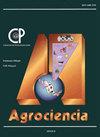PROJECTIVE LEAF COVER PREDICTS PLANT SPECIES RICHNESS IN THE SACRED FIR FORESTS OF MONTE TLÁLOC, STATE OF MEXICO
IF 0.5
4区 农林科学
Q4 AGRICULTURE, MULTIDISCIPLINARY
引用次数: 0
Abstract
The establishment of relationships between the water balance coupled to the atmosphere and species richness, for a given ecosystem, allows characterizing the state of vegetation under stable conditions. The proposal by Specht and colleagues of the water relationship between actual evapotranspiration/potential evapotranspiration (Ea/Eo), mediated by the evaporative coefficient k, allows to establish empirical relationships, without implying a cause-effect relationship, between the projective leaf cover (CPF) and the richness of plant species in relation to k. These relationships were reviewed with information from sampling sites established in sacred fir [Abies religiosa (Kunth) Schltdl. & Cham.] forests of the warm temperate climatic region of Mount Tlaloc, State of Mexico. Species richness and CPF of the upper stratum of the forests were measured, and the aboveground biomass was estimated. The patterns of the relationship between the CPF of the upper stratum and the total number of species showed variations within the limits of Specht’s equilibrium relationship, even though the levels of disturbing agents in the sites showed a greater dispersion of the data. Establishing a relationship between projective leaf cover and species richness facilitates estimates in plant diversity conservation projects.投影叶覆盖预测植物物种丰富度在蒙特tlÁloc,墨西哥州的神圣冷杉森林
对于给定的生态系统,建立与大气耦合的水平衡与物种丰富度之间的关系,可以表征稳定条件下植被的状态。Specht及其同事提出的实际蒸散发/潜在蒸散发(Ea/Eo)之间的水分关系,由蒸发系数k介导,允许在投影叶盖度(CPF)与植物物种丰富度(k)之间建立经验关系,而不暗示因果关系。这些关系通过在神圣冷杉[Abies religiosa (Kunth) Schltdl建立的采样点的信息进行了审查。,可汗。墨西哥州塔拉克山温暖温带地区的森林。测量了森林上层的物种丰富度和CPF,估算了地上生物量。上层CPF与物种总数之间的关系模式在Specht平衡关系的范围内表现出变化,即使在站点的干扰物水平显示出更大的数据分散。建立投影叶盖度与物种丰富度之间的关系有助于植物多样性保护项目的评估。
本文章由计算机程序翻译,如有差异,请以英文原文为准。
求助全文
约1分钟内获得全文
求助全文
来源期刊

Agrociencia
农林科学-农业综合
CiteScore
0.50
自引率
33.30%
发文量
51
审稿时长
18-36 weeks
期刊介绍:
AGROCIENCIA is a scientific journal created and sponsored by the Colegio de Postgraduados. Its main objective is the publication and diffusion of agricultural, animal and forestry sciences research results from mexican and foreign scientists. All contributions are peer reviewed. Starting in the year 2000, AGROCIENCIA became a bimonthly and fully bilingual journal (Spanish and English versions in the same issue). Since 2007 appears every month and a half (eight issues per year). In addition to the printed issues, the full content is available in electronic format.
 求助内容:
求助内容: 应助结果提醒方式:
应助结果提醒方式:


